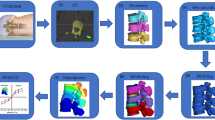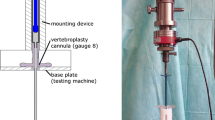Abstract
Purpose
Vertebroplasty restores stiffness and strength of fractured vertebral bodies, but alters their stress transfer. This unwanted effect may be reduced by using more compliant cements. However, systematic experimental comparison of structural properties between standard and low-modulus augmentation needs to be done. This study investigated how standard and low-modulus cement augmentation affects apparent stiffness, strength, and endplate pressure distribution of vertebral body sections.
Methods
Thirty-nine human thoracolumbar vertebral body sections were prepared by removing cortical endplates and posterior elements. The specimens were scanned with a HR-pQCT system and loaded in the elastic range. After augmentation with standard or low-modulus cement they were scanned again and tested in two steps. First, the contact pressure distribution between specimen and loading plates was measured with pressure-sensitive films. Then, they were loaded again in the elastic range and compressed until failure. Apparent stiffness was compared before and after augmentation, whereas apparent strength of augmented specimens was compared to a non-augmented reference group.
Results
Vertebral body sections with fillings connecting both endplates were on average 33% stiffer and 47% stronger with standard cement, and 27% stiffer and 30% stronger with low-modulus cement. In contrast, partial fillings showed no significant strengthening for both cements and only a slight stiffness increase (<16%). The averaged endplate pressure above/below the cement was on average 15% lower with low-modulus cement compared to standard cement.
Conclusion
Augmentation connecting both endplates significantly strengthened and stiffened vertebral body sections also with low-modulus cement. A trend of reduced pressure concentrations above/below the cement was observed with low-modulus cement.









Similar content being viewed by others
References
Belkoff SM, Mathis JM, Jasper LE, Deramond H (2001) The biomechanics of vertebroplasty. The effect of cement volume on mechanical behavior. Spine 26(14):1537–1541
Liebschner MA, Rosenberg WS, Keaveny TM (2001) Effects of bone cement volume and distribution on vertebral stiffness after vertebroplasty. Spine 26(14):1547–1554
Serra L, Mehrabi Kermani F, Panagiotopoulos K, De Rosa V, Vizioli L (2007) Vertebroplasty in the treatment of osteoporotic vertebral fractures: results and functional outcome in a series of 175 consecutive patients. Minim Invasive Neurosurg 50:12–17
Grados F, Depriester C, Cayrolle G, Hardy N, Deramond H, Fardellone P (2000) Long-term observations of vertebral osteoporotic fractures treated by percutaneous vertebroplasty. Rheumatology 39:1410–1414
Uppin AA, Hirsch JA, Centenera LV, Pfiefer BA, Pazianos AG, Choi IS (2003) Occurrence of new vertebral body fracture after percutaneous vertebroplasty in patients with osteoporosis. Radiology 226(1):119–124
Berlemann U, Ferguson SJ, Nolte LP, Heini PF (2002) Adjacent vertebral failure after vertebroplasty. A biomechanical investigation. J Bone Joint Surg Br 84(5):748–752
Boger A, Heini PF, Windolf M, Schneider E (2007) Adjacent vertebral failure after vertebroplasty: a biomechanical study of low-modulus PMMA cement. Eur Spine J 16(12):2118–2125
Nouda S, Tomita S, Kin A, Kawahara K, Kinoshita M (2009) Adjacent vertebral body fracture following vertebroplasty with polymethylmethacrylate or calcium phosphate cement: biomechanical evaluation of the cadaveric spine. Spine 34(24):2613–2618
Klazen CAH, Venmans A, de Vries J, van Rooij WJ, Jansen FH, Blonk MC, Lohle PNM, Juttmann JR, Buskens E, van Everdingen KJ, Muller A, Fransen H, Elgersma OE, Mali WPThM, Verhaar HJJ (2010) Percutaneous vertebroplasty is not a risk factor for new osteoporotic compression fractures: results from VERTOS II. Am J Neuroradiol 31:1447–1450
Baroud G, Nemes J, Heini PF, Steffen T (2003) Load shift of the intervertebral disc after a vertebroplasty: a finite-element study. Eur Spine J 12(4):421–426
Polikeit A, Nolte LP, Ferguson SJ (2003) The effect of cement augmentation on the load transfer in an osteoporotic functional spinal unit: finite-element analysis. Spine 28(10):991–996
Banse X, Sims TJ, Bailey AJ (2002) Mechanical properties of adult vertebral cancellous bone: correlation with collagen intermolecular cross-links. J Bone Miner Res 17:1621–1628
Kühn KD (2000) Bone Cements. Up-to-date comparison of physical and chemical properties of commercial materials, vol 1. Springer, Berlin
Boger A, Bohner M, Heini PF, Schwieger K, Schneider E (2008) Performance of vertebral cancellous bone augmented with compliant PMMA under dynamic loads. Acta Biomater 4:1688–1693
Chevalier Y, Pahr DH, Charlebois M, Heini PF, Schneider E, Zysset PK (2008) Cement distribution, volume, and compliance in vertebroplasty: some answers from an anatomy-based nonlinear finite element study. Spine 33(16):1722–1730
Graham J, Ahn C, Hai N, Buch BD (2007) Effect of bone density on vertebral strength and stiffness after percutaneous vertebroplasty. Spine 32(18):505–511
Dall’Ara E, Schmidt R, Pahr DH, Varga P, Patsch J, Chevalier Y, Kainberger F, Zysset PK (2010) A nonlinear finite element model validation study based on a novel experimental technique for inducing anterior wedge-shape fractures in human vertebral bodies in vitro. J Biomech 43(12):2374–2380
Furtado N, Oakland RJ, Wilcox RK, Hall RM (2007) A biomechanical investigation of vertebroplasty in osteoporotic compression fractures and in prophylactic vertebral reinforcement. Spine 32(17):480–487
Heini PF, Berlemann U, Kaufmann M, Lippuner K, Fankhauser C, van Landuyt P (2001) Augmentation of mechanical properties in osteoporotic vertebral bones—a biomechanical investigation of vertebroplasty efficacy with different bone cements. Eur Spine J 10(2):164–171
Higgins KB, Harten RD, Langrana NA, Reiter MF (2003) Biomechanical effects of unipedicular vertebroplasty on intact vertebrae. Spine 28(14):1540–1547
Boger A, Wheeler K, Montali A, Gruskin E (2009) NMP-modified PMMA bone cement with adapted mechanical and hardening properties for the use in cancellous bone augmentation. J Biomed Mater Res B Appl Biomater 90(2):760–766
Laib A, Rüegsegger P (1999) Comparison of structure extraction methods for in vivo trabecular bone measurements. Comput Med Imaging Graph 23:69–74
Pahr DH, Zysset PK (2009) From high-resolution CT data to finite element models: development of an integrated modular framework. Comput Meth Biomech Biomed Eng 12:45–57
Leng L, Zhang T, Kleinman L, Zhu W (2007) Ordinary least squares regression, orthogonal regression, geometric mean regression and their application in aerosol science. J Phys Conference Series 78:012084–012088
Steens J, Verdonschot N, Aalsma AMM, Hosman AJF (2007) The influence of endplate-to-endplate cement augmentation on vertebral strength and stiffness in vertebroplasty. Spine 32(15):419–422
Hulme PA, Boyd SK, Heini PF, Ferguson SJ (2009) Differences in endplate deformation of the adjacent and augmented vertebra following cement augmentation. Eur Spine J 18(5):614–623
Eswaran SK, Gupta A, Adams MF, Keaveny TM (2006) Cortical and trabecular load sharing in the human vertebral body. J Bone Miner Res 21(2):307–314
Kobayashi N, Numaguchi Y, Fuwa S, Uemura A, Matsusako M, Okajima Y, Ishiyama M, Takahashi O (2009) Prophylactic vertebroplasty: cement injection into non-fractured vertebral bodies during percutaneous vertebroplasty. Acad Radiol 16(2):136–143
Diel P, Freiburghaus L, Röder C, Benneker LM, Popp A, Perler G, Heini PF (2011) Safety, effectiveness and predictors for early reoperation in therapeutic and prophylactic vertebroplasty: short-term results of a prospective case series of patients with osteoporotic vertebral fractures. Eur Spine J. doi:10.1007/s00586-011-1989-x
Acknowledgments
The authors acknowledge the AO Research Foundation for grant support, Synthes GmbH for providing the cement and injection kits, Prof. Klaus Hoffmann (IKL, Vienna University of Technology) for providing the software GODAV, Prof. Paul Heini (Sonnenhofklinik, Bern, Switzerland) for his clinical expertise, Thomas Bandur for preparation the vertebral bodies and Christoph Messner for assistance in the laboratory. Special thanks to Enrico Dall’Ara for fruitful discussion and advice with specimen preparation and mechanical testing.
Conflict of interest
None.
Author information
Authors and Affiliations
Corresponding author
Rights and permissions
About this article
Cite this article
Kinzl, M., Benneker, L.M., Boger, A. et al. The effect of standard and low-modulus cement augmentation on the stiffness, strength, and endplate pressure distribution in vertebroplasty. Eur Spine J 21, 920–929 (2012). https://doi.org/10.1007/s00586-011-2119-5
Received:
Revised:
Accepted:
Published:
Issue Date:
DOI: https://doi.org/10.1007/s00586-011-2119-5




